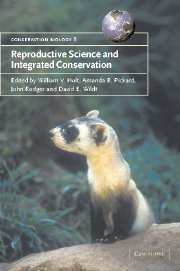Book contents
- Frontmatter
- Contents
- List of contributors
- Foreword
- Part I Introduction
- Part II Reproduction and population viability
- Part III Reproductive techniques for conservation management
- Part IV Integrated conservation management
- Part V Reproduction science in non-mammalian species
- Part VI Conclusions
- 25 Postscript — sex, wildlife and vindication
- Index
25 - Postscript — sex, wildlife and vindication
Published online by Cambridge University Press: 21 January 2010
- Frontmatter
- Contents
- List of contributors
- Foreword
- Part I Introduction
- Part II Reproduction and population viability
- Part III Reproductive techniques for conservation management
- Part IV Integrated conservation management
- Part V Reproduction science in non-mammalian species
- Part VI Conclusions
- 25 Postscript — sex, wildlife and vindication
- Index
Summary
Anyone reading the contributions that together make up this book should be impressed by the web of interdisciplinary interactions that springs unbidden from the pages. Chapters about genetic aspects of small populations, whether involving animals in the wild or in zoos, introduce concepts that help us appreciate the need for strong management policies. Accounts of reintroduction programmes, where the genetic principles are applied in practice, succeed in highlighting the complexities of returning animals to nature while, in some cases, requiring other species to be controlled as pests or over-abundant populations. Assessing behaviour or reproductive hormone status without the need for intrusion provides crucial information about the reproductive status of wild populations, as well as helping curators to manage captive animals to high welfare standards. At the heart of this wonderful web of integrative science lies the high priority of always needing to understand the fundamental biology of the species in question.
As discussed by Wildt et al. in the first chapter, the discipline of reproduction is often perceived as ‘techno-based’, with little to offer to real conservation. This, combined with a natural suspicion in the conservation community of ‘quick-fixes’, has left the field with an image of limited utility (mostly for combating human infertility or accelerating livestock production) or, worse, occasional gee-whiz births published only in newspapers. One of our intentions in compiling this book was to rid the Earth of this impression forever.
- Type
- Chapter
- Information
- Reproductive Science and Integrated Conservation , pp. 396 - 400Publisher: Cambridge University PressPrint publication year: 2002

